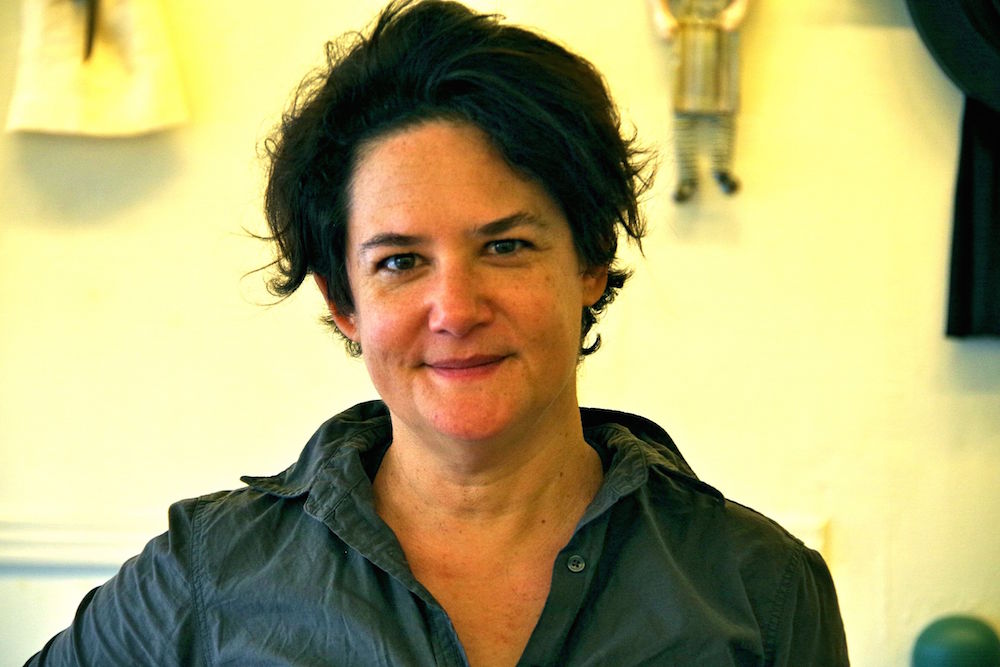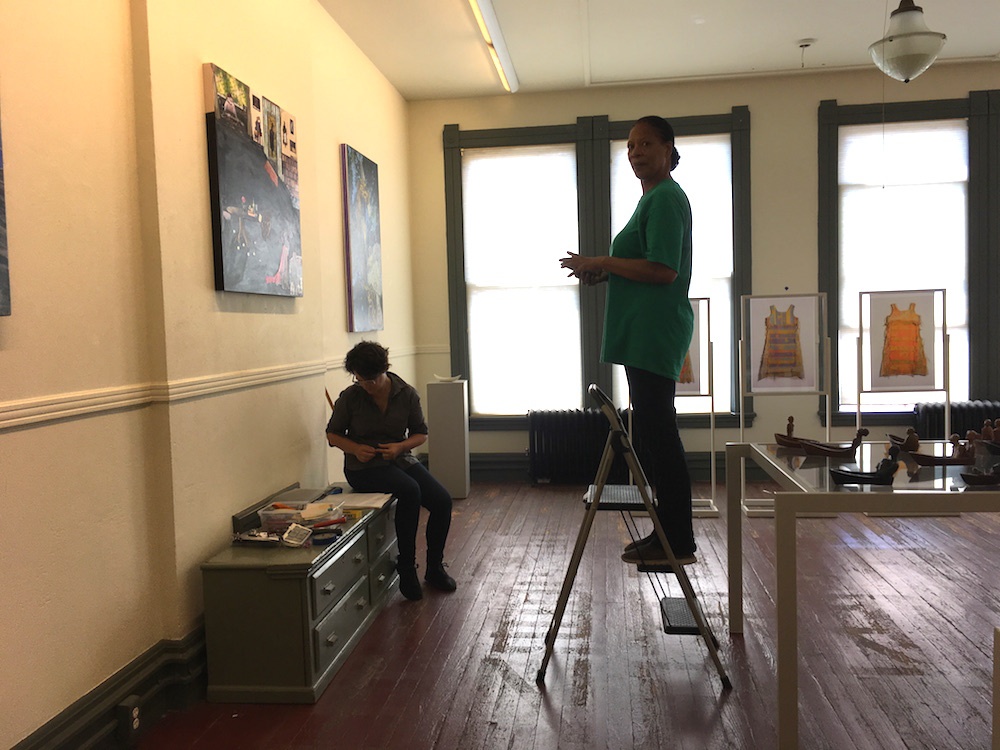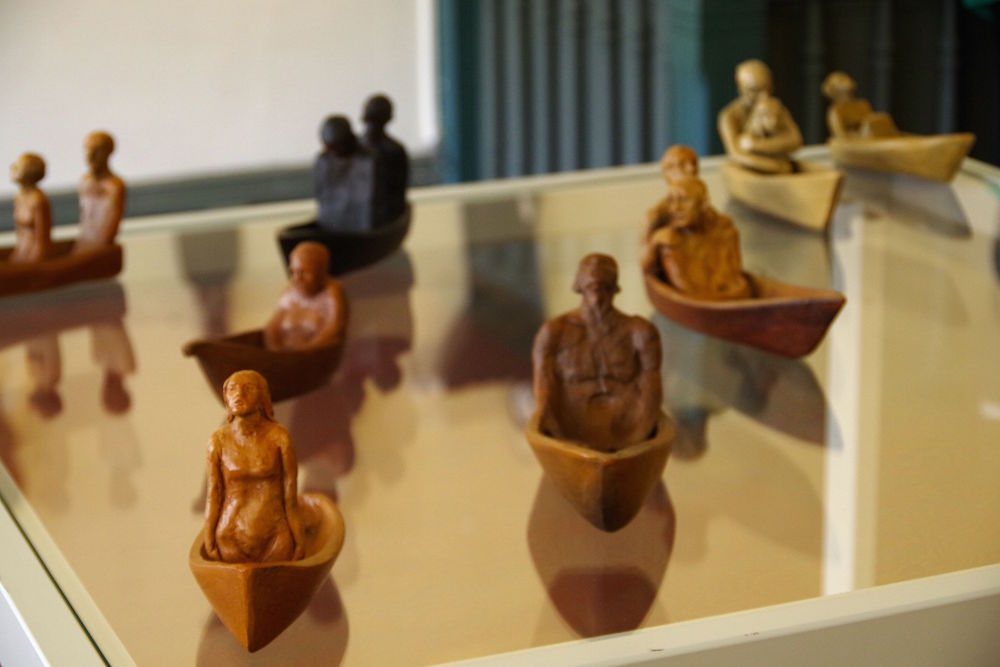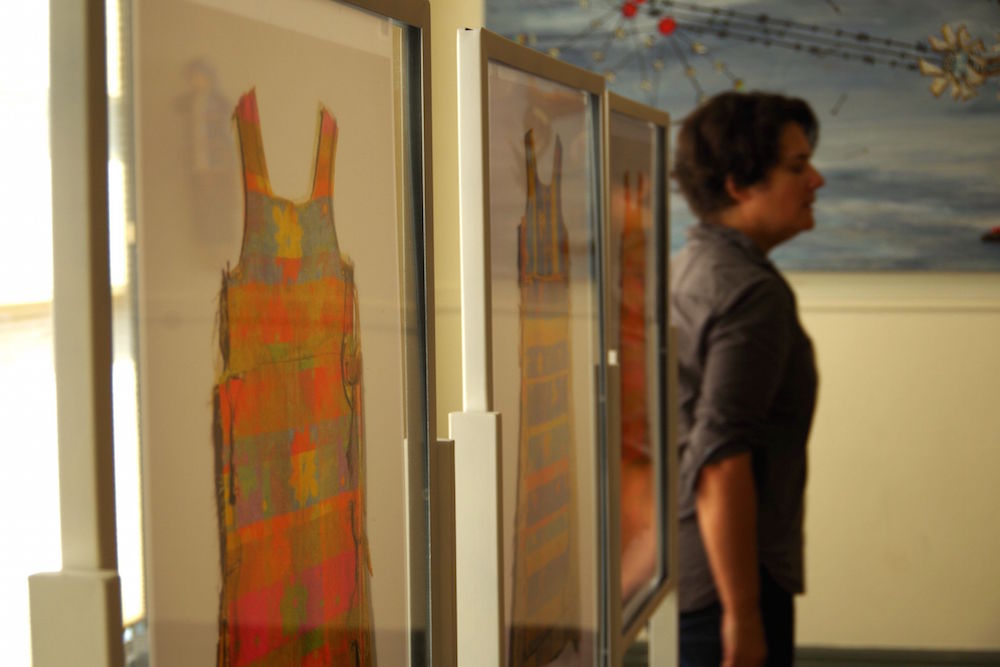It’s the cutout of the tidily dressed black woman that snags your attention. Floating in the lower right of a large, silkily black canvas, she bends at the waist, a corset pulling in her stomach as two hands rest squarely on her hips. She watches two copper pots, the red of her dress reflected in their shiny sides. In the doorway above, a figure looms ominously, walking through a mesh of thick moss to the open front door.
Even before you’ve fully digested the work, there are so many questions. Is she a homeowner? A servant? Perhaps Red Riding Hood all grown up? Does she want to eat the food or is she preparing it for someone else? Does she notice the visitor at the door, and is he expected? What is he going to do when he reaches the doorway, anxd comes right in?
So unfolds Clymenza Hawkins’ eye-grabbing Qetello, one of several works now on view in The Plot Thickens at the Institute Library (IL) on Chapel Street. Intended to both herald and expand dialogue around myths, foktales, and fairytales, the exhibition opens this week in the IL’s upstairs gallery space and second-floor reading room. It runs from Sept. 9 to Oct. 31.

Lewis during the final stages of the install. Lucy Gellman photo.
The sinister magic, vagary and violence of fairy tales—and their extensive rewritings— drew IL Curator-In-Residence Martha Lewis to the project. She grew up reading fairy tales and myths, mapping onto multiple characters as she read.
From childhood to graduate school, works by C.S. Lewis, Margaret Atwood, Anthony Burgess, Carl Jung and others—many, many others— were a revelation to her, expanding her world with each page.
“It’s a way of talking about sex, domesticity, the inside world, the outside world, family,” she said last Thursday, bobbing around the IL’s gallery space. “It allows you to have a conversation about these things, but in a way that’s more appealing.”
Little did she know that artists around the region were doing the same thing in their work. Like Hawkins with Qetello, which means “fate” in the South African Sesotho language. Inspired in part by by Angela Carter’s The Erl-King, Hawkins said the work reimagines multiple fairy tales, including Goldilocks and the Three Bears (specifically the domestic invasion, Lewis noted).

It’s part of her multimedia oeuvre, a series of painting-collages that engage writings including The Brothers Grimm, Charles Perrault, Jack Zipes, Zora Neale Hurston, Octavia Butler, Shirley Jackson, and Clarissa Pinkola Estés.
“My work is transformation…I always like to mix in other cultures,” she said Thursday, hanging the work in the Institute Library’s upstairs gallery space on Chapel Street. “Fairy folktales—they’re very universal.”
In the light-flooded upstairs gallery, Qetello has good company. From two new display cases, Christopher Manning’s polaroid collages (pictured above) pull viewers in with almost cosmic force, strange and majestic as they sit flat under glass. In one, a nest of painted white rope nearly obscures a face, smiling and winking out from below it.
In another, a long nose and set pair of lips peek out, sturdy and unmoving. A circle of paint hides the rest of the face, leaving the viewer to wonder if they are looking at skin or stone.

Clinard's boats. Lucy Gellman Photo.
Nearby, an extraordinary series of Susan Clinard’s clay boats glides across glass, marooned in the middle of the gallery. As a female figure leads them to the edge of a glass vitrine, she looks upwards, her eyes fixed on something in the distance that we cannot see. Here I am, a supplicant, she seems to say, propping up herself up on her knees with arms glued to her sides. It is a gesture of both devotion and defeat, her exhaustion rising from the hardened clay and into the gallery.
So too is Lani Asuncion’s 3 Sisters: SustainABLE, three digital prints of handmade dresses that Asuncion has made. Based on the “three sisters” of the Indian harvest (corn, beans, and squash), Asuncion’s work—flooded with natural light from its place by the gallery’s window—brings together not only family interconnectedness, but land grabbing, use, and colonialism. Just to their right, two miniature figures appear to look on, stranded by a fried telephone pole in Margaret Ann Withers’ quirky and post-Apocalyptic work.

The 3 Sisters . Lucy Gellman Photo.
In this way The Plot Thickens is darkly whimsical, but also deeply timely. Clinard, Chris Barnard (the Root Rot series) and Nathan Lewis weave together a moving narrative on water, migration, displacement and death. A loop of Maya Deren’s 1943 film Meshes of the Afternoon brings in suicide and drpression, also on bright display in one of Lewis’ lush Ophelia-like figures.
Lewis said she couldn’t have anticipated that the show’s opening would coincide with hurricanes Harvey and Irma, but finds a somber connection between the works, collective histories, and the myths that inspired them. She can't unsee the coincidence, she said -- and is just waiting to see how the ending will be written.
The Institute Library is open 10 a.m. to 6 p.m. Monday through Friday, and 11 a.m. to 2 p.m. Saturday. Closed Sundays. To learn more, visit its website.